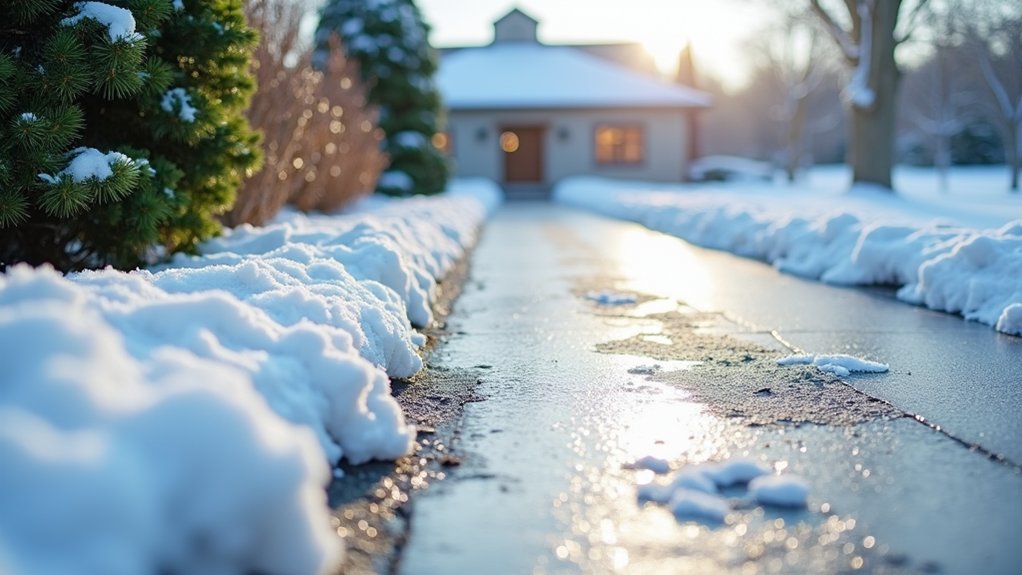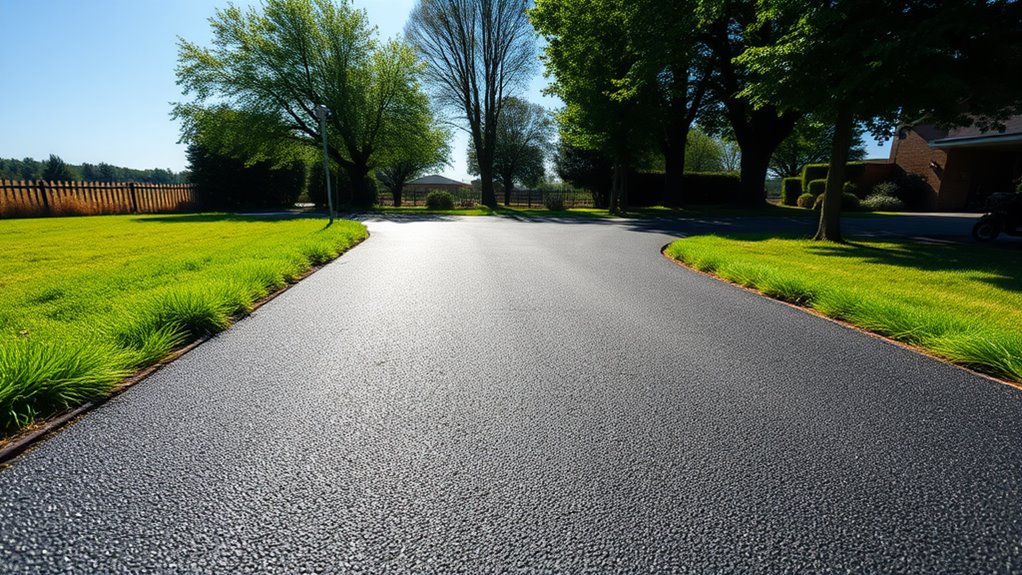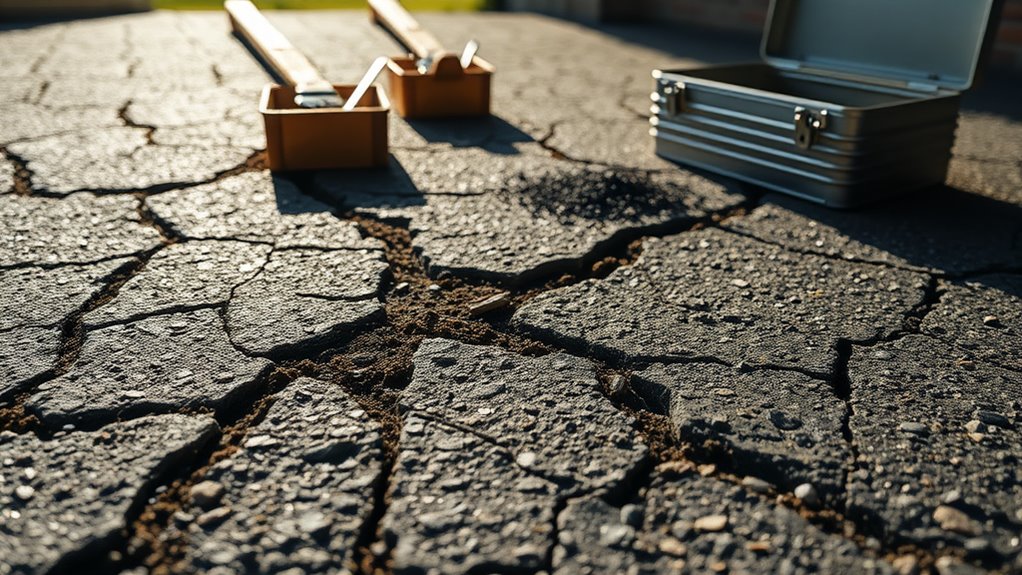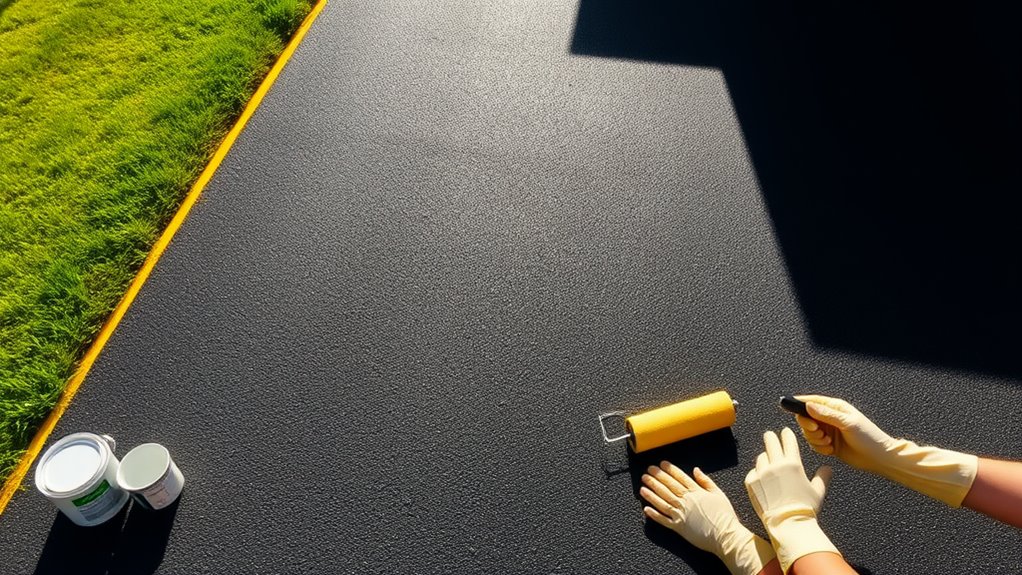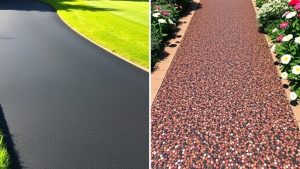To prevent your driveway from cracking in cold weather, it’s essential to seal and waterproof it properly. Apply sealants when temperatures are above 10°C to ensure good adhesion, forming a barrier against moisture. Regularly clean the surface using a pressure washer to maintain clear drainage and avoid water pooling. Check for cracks and use flexible caulking for minor repairs. By following these steps, you can significantly enhance your driveway’s durability.
Table of Contents
ToggleKey Takeaways
- Apply sealant to your driveway before winter to create a waterproof barrier against freeze-thaw cycles.
- Regularly clean the surface with a pressure washer to remove dirt and organic matter that can hold moisture.
- Check for cracks and repair them promptly using flexible sealant or hot pour crack fillers.
- Ensure your drainage system is clear to prevent water pooling, which can lead to cracking.
- Schedule regular inspections and keep a record of maintenance to catch issues early and ensure your driveway remains in good condition.
Importance of Seal and Waterproofing Measures
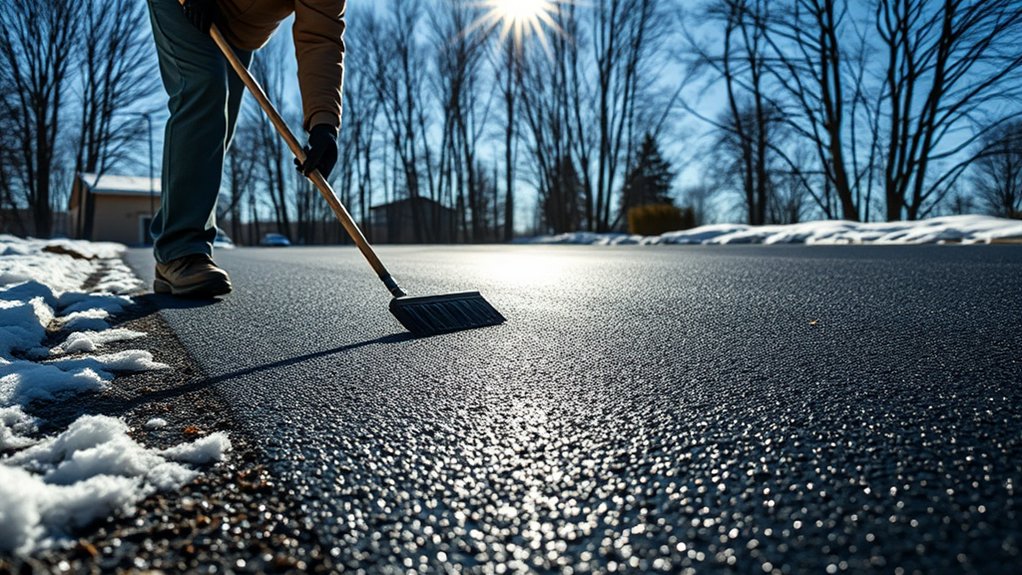
Seal and waterproofing measures are essential for preserving your driveway’s integrity, particularly during cold weather.
Applying sealcoating before winter improves your driveway’s resistance to cracking from freeze-thaw cycles. A good sealant creates a waterproof barrier that prevents moisture from penetrating, which can lead to deterioration of the material. To ensure sealants bond effectively, it’s crucial to follow proper waterproofing techniques, as weak bonds can leave your driveway vulnerable. Aim to apply sealants when temperatures are above 10°C (50°F) for optimal adhesion and to reduce curing time. Additionally, consistent temperatures above 50°F are necessary to ensure the sealcoat adheres properly and lasts longer. Regularly conducting annual inspections of your driveway can help identify any issues before they worsen.
Regular sealcoating not only protects your driveway but also extends its lifespan, helping you avoid costly repairs down the line.
Effective Cleaning and Surface Preparation Techniques
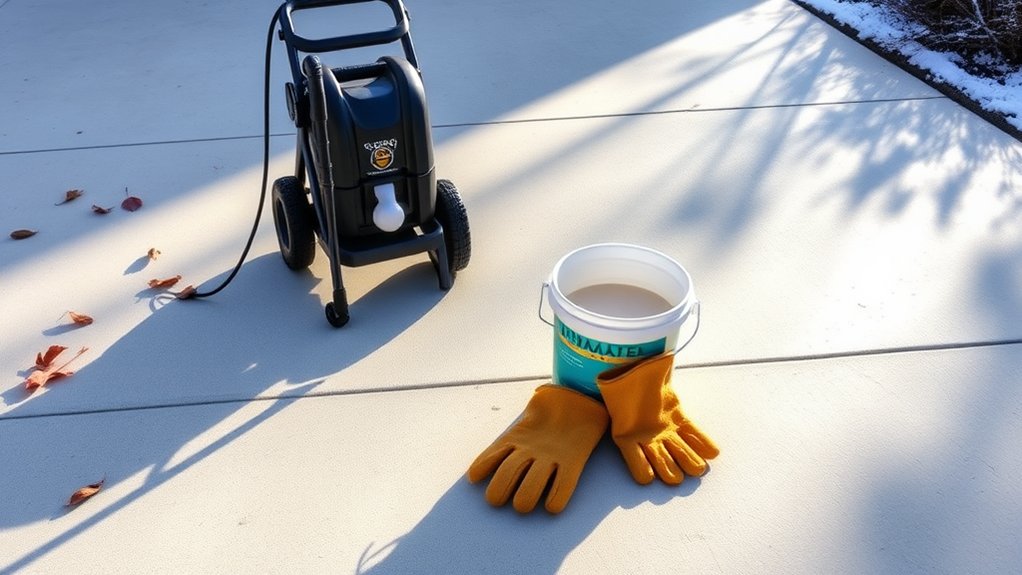
To keep your driveway in good condition, effective cleaning and surface preparation are key.
Start by pressure washing to remove dirt and organic matter that could retain moisture. Additionally, maintaining a clear drainage system ensures that water does not pool, which can cause cracks in colder weather. Regular inspections for common issues can help identify potential problems before they worsen, further protecting your driveway’s surface.
Power Washing Driveway Surfaces
When preparing to power wash your driveway, it’s essential to choose the right equipment and techniques for the best results. Use a pressure washer with a PSI between 2500 and 3200, and attach a surface cleaner for an even finish. A 25-degree nozzle offers a good mix of power and coverage, while keeping a distance of 30 to 45 cm helps prevent damage to the surface. Start at the highest point of the driveway and work side to side, overlapping by about 15 cm for thorough cleaning.
Additionally, using a Surface Cleaner ensures more effective cleaning and prevents wave patterns during the process. After washing, make sure to rinse well to remove any dirt that has been loosened. Regular pressure washing can help maintain the integrity of your driveway by preventing early signs of growth that may lead to further damage. Always test the pressure washer on a small, inconspicuous area first and check all connections are secure to prevent any interruptions while washing. Proper preparation is key to effective cleaning.
Debris and Organic Material Removal
After pressure washing your driveway, it’s crucial to tackle debris and organic material to preserve its condition, especially with colder weather on the horizon. Clearing away items like leaves and branches helps prevent organic build-up that can freeze and damage the surface. Regularly sweep or use a blower to remove leaves, and trim any overhanging branches to lessen snow load. Check for hidden objects that may get caught during snow clearing, and ensure your gutters are unobstructed to avoid drainage problems.
| Debris Type | Impact on Driveway |
|---|---|
| Large Items | Can freeze, leading to cracks |
| Organic Build-up | Aids ice formation |
| Hidden Objects | Can damage snow removal tools |
Drainage System Maintenance
Maintaining your drainage system is crucial for preventing damage to your driveway during colder months. Start by regularly clearing blockages; remove leaves and debris from drain grates and channels to ensure proper water flow.
Inspect components thoroughly, paying particular attention to metal parts for rust or distortion. Conduct annual visual checks and consider using methods like dye testing to spot hidden problems. Water testing can help identify leaks, while pressure washing is effective for removing stubborn sediment.
Promptly repair or replace any damaged components to keep the system functioning well. A well-maintained drainage system not only protects your driveway but also extends its life, reducing the risk of cracking in harsh winter conditions.
Strategies for Crack and Damage Repair
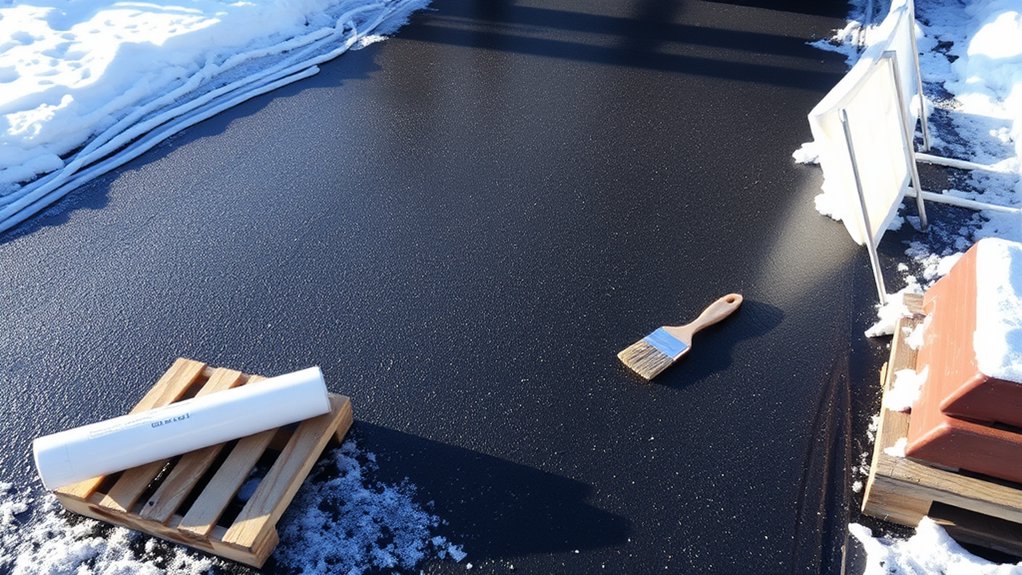
To ensure your driveway can endure harsh cold weather, a systematic approach to crack and damage repair is essential.
Begin with a thorough inspection to identify any existing cracks or weak spots. For minor cracks, use flexible caulking or cold patch asphalt for quick fixes. For more significant repairs, opt for hot pour crack fillers, and consider using a device like the HOTBOX10 for the best results.
Carry out repairs during the warmer parts of the day to maximise effectiveness. Once repairs are complete, apply a seal coat to protect against moisture and the freeze-thaw cycle.
Regular maintenance, including inspections and timely repairs, is crucial for extending the life of your driveway and ensuring it remains resilient against cold weather challenges.
Best Practices for Snow and Ice Management

To effectively manage snow and ice, implement strategic snow removal techniques and safe de-icing alternatives.
Start by clearing snow in stages during a storm to prevent it from compacting.
Consider using eco-friendly de-icers to minimise damage to your surfaces.
Snow Removal Techniques
How can you ensure your driveway stays in good condition throughout the winter? Effective snow removal techniques are key. Here are some best practices to follow:
- Choose Ergonomic Tools: Use shovels designed to reduce strain and make the task easier.
- Push Rather Than Lift: When clearing snow, push it off the driveway instead of lifting to prevent damaging the edges.
- Clear Regularly: Remove snow frequently to avoid compaction and ice build-up, which can lead to cracks.
- Check After Snowfalls: After a storm, inspect for any leftover snow or ice that needs clearing.
Safe Deicing Alternatives
Once the snow is cleared, the next step in keeping your driveway in good shape during winter is to choose the right deicing alternatives.
Consider using Calcium Magnesium Acetate (CMA), which is environmentally friendly; it’s biodegradable and less corrosive than traditional rock salt, making it gentler on your driveway. It works well in temperatures down to -6°C. Although it may be pricier upfront, the savings on long-term maintenance can be worth it.
You might also look into chloride alternatives like magnesium chloride and potassium chloride. These options effectively lower the freezing point while being kinder to plants and paving.
Liquid deicers can provide an even spread, making them more efficient and reducing waste. Be sure to apply them carefully to ensure they work effectively and minimise environmental impact.
Choose wisely for a safer driveway this winter.
Drainage and Water Control Solutions
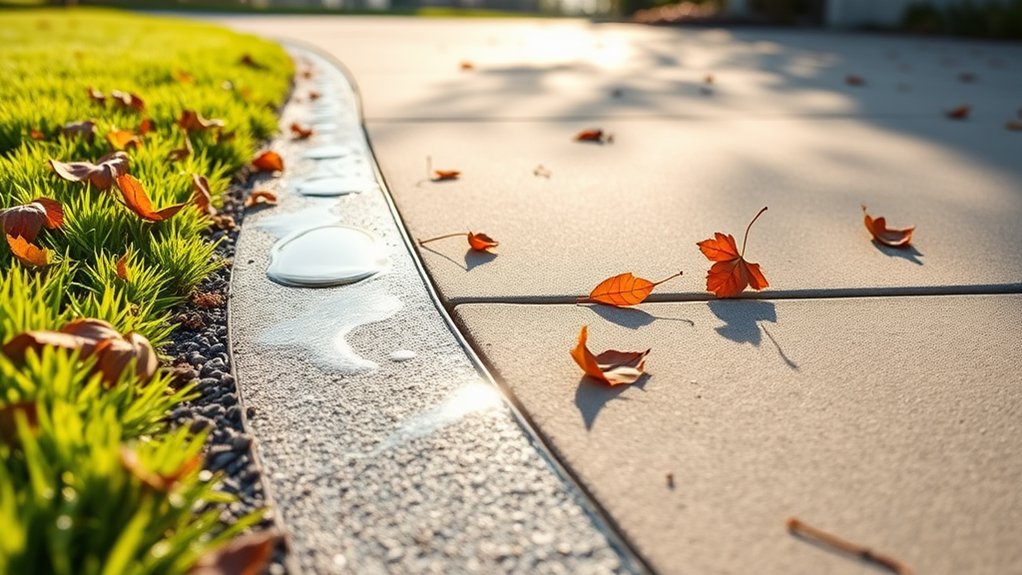
Effective drainage and water control solutions are vital for preventing driveway cracking during cold weather. Poorly managed water can cause freeze-thaw damage, so it’s important to implement the right technologies for proper water diversion.
Here are four key solutions:
- Channel Drains: These are ideal for sloped driveways, as they efficiently capture and redirect water.
- Slot Drains: Choose these modern systems to avoid visible grates and enhance the look of your driveway.
- PVC Redirects: Use PVC piping with channel drains to direct water towards suitable disposal systems.
- NDS Pop-Up Emitters: These help prevent freezing and stagnation in your drainage system, ensuring smooth operation.
Routine Maintenance and Monitoring Procedures
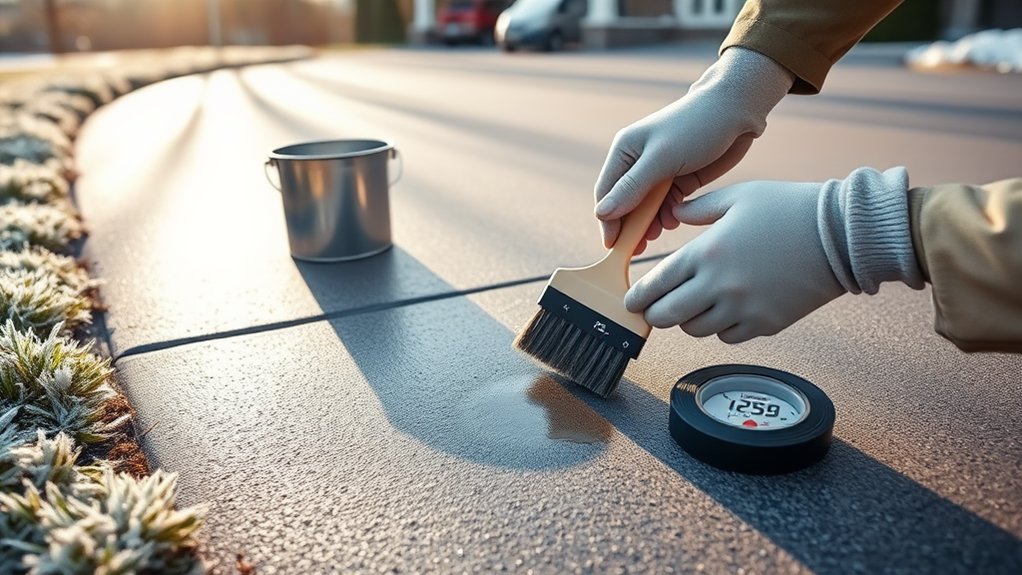
With effective drainage systems in place, it’s essential to implement routine maintenance and monitoring procedures to protect your driveway from cold weather damage.
Begin by regularly inspecting your driveway for cracks, potholes, or uneven surfaces, allowing for timely repairs. Keep an eye on temperature fluctuations that can lead to material expansion and contraction.
Clear away debris and carry out an annual pressure wash to prevent moisture build-up. Document all maintenance activities to keep track of progress and recurring issues.
Seal any cracks before winter arrives, and promptly clean oil stains to reduce slipping hazards. Regularly shovel snow and apply eco-friendly de-icers as necessary to minimise ice formation, ensuring your driveway remains safe and in good condition.
Choosing the Right Sealants and Coatings

Choosing the right sealants and coatings for your driveway is crucial for its durability, especially in the face of cold weather. Knowing the different types of sealants and how to apply them can help you make a wise decision:
- Polyurethane Sealants: Ideal for extreme temperatures and heavy rainfall.
- Latex Acrylic Sealants: Offer long-lasting protection, typically needing resealing every 5 to 10 years.
- Penetrating Sealers: Guard against water damage and the effects of freezing and thawing.
- Epoxy Sealants: Very durable but can be slippery when wet.
When applying products like Latex-ite Therma Seal, opt for cooler conditions and ensure you follow the recommended temperature ranges for the best results.
Balancing functionality with aesthetic appeal can significantly enhance both the protection and look of your driveway.
Professional Assistance for Driveway Care
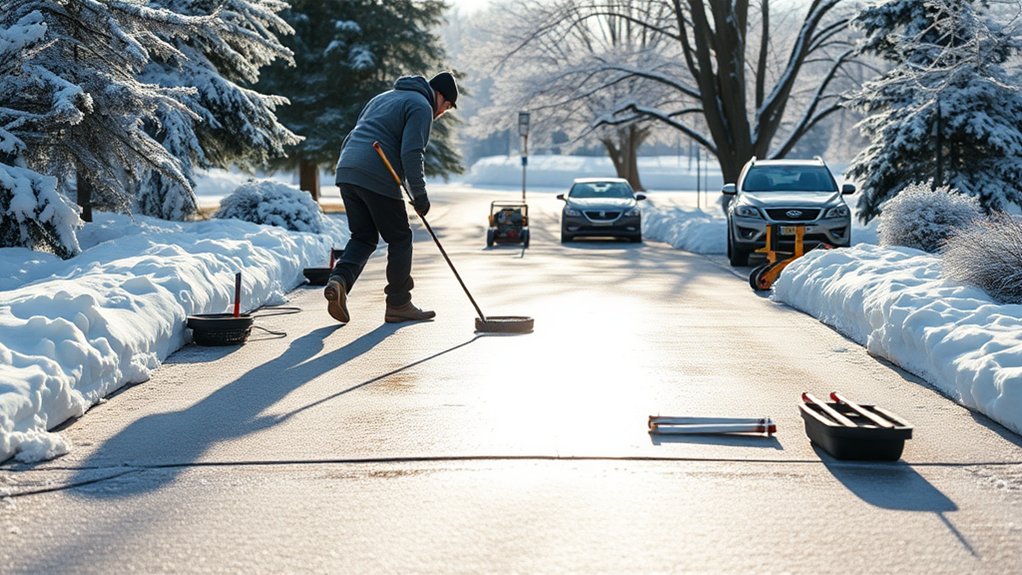
While many homeowners try DIY driveway maintenance, hiring a professional can significantly improve the care of your driveway. Experts can conduct thorough assessments to uncover underlying issues that you might miss. They use specialised equipment and techniques, ensuring effective cleaning without damaging the surface.
By promptly addressing cracks and sealant needs, professionals help prevent water infiltration, which is especially important during colder months.
Additionally, tailored solutions from professionals can extend your driveway’s lifespan and enhance its appearance. Regular maintenance by experts allows for the removal of stubborn stains and restores the surface in ways DIY methods may not achieve.
Ultimately, professional assistance not only protects your investment but also ensures your driveway remains functional and attractive for years to come.
Frequently Asked Questions
How Do Temperature Fluctuations Affect Driveway Materials?
Temperature fluctuations affect driveway materials by causing them to expand and contract. For example, asphalt driveways tend to cope better with these changes, which helps prevent cracking and increases durability. In contrast, less resilient materials may struggle, leading to more maintenance issues over time. It’s important to choose the right material to withstand the UK’s varying climate.
Can Driveway Design Impact Its Durability in Winter?
Driveway design significantly affects its durability in winter. Selecting the right materials and ensuring proper winter maintenance—such as sealing and effective drainage—can greatly improve your driveway’s ability to withstand cold weather damage. For instance, opting for reinforced concrete or high-quality tarmac can help prevent cracking and surface deterioration during frost.
What Are the Signs of Concrete Freeze Damage?
Look out for crack patterns from freeze-thaw cycles, such as hairline fractures, spalling, and scaling. Discolouration, surface pitting, and pop-outs are also signs of significant freeze damage to your concrete.
Are There Eco-Friendly Options for Driveway Sealants?
If you’re looking into driveway sealants, consider eco-friendly choices like water-based or soy-based sealants. These options are better for the environment and still offer solid protection, although you may need to reapply them more often than traditional sealants.
How Often Should I Conduct Driveway Inspections?
For effective driveway maintenance, it’s advisable to inspect your driveway at least once a year, or more often after heavy snowfall. Regular checks help you identify issues early, ensuring your driveway lasts longer and remains safe for use. For example, after a harsh winter, look for cracks or signs of wear that might need attention before they become bigger problems.
Conclusion
To summarise, preventing cracks in your driveway during cold weather requires a mix of proactive steps and regular upkeep. Effective sealing and waterproofing, managing snow and ice, and ensuring proper drainage can significantly extend the life of your driveway. Research indicates that well-maintained driveways can reduce repair costs by as much as 50%. Therefore, putting in the effort to care for your driveway not only improves its appearance but also offers significant cost savings in the long run.
Maximize the durability of your tarmac driveway by understanding the ideal weather conditions for installation—discover the secrets to perfect timing Read more
Discover the common causes of tarmac driveway cracks and learn effective repair methods to protect your investment—your driveway deserves the Read more
Before you paint your tarmac driveway, discover essential tips and techniques that can transform its appearance and durability—don't miss out Read more

